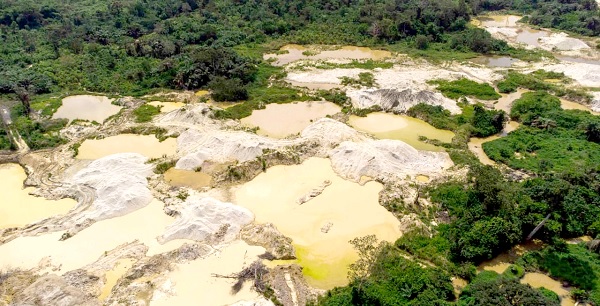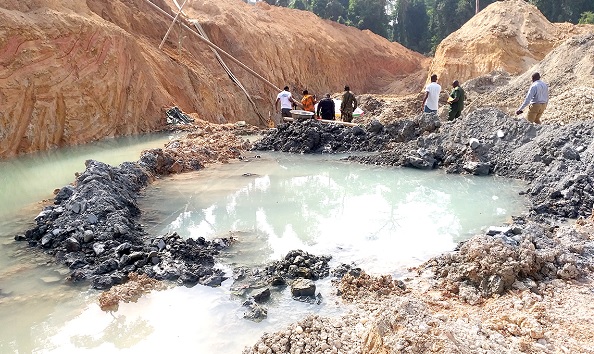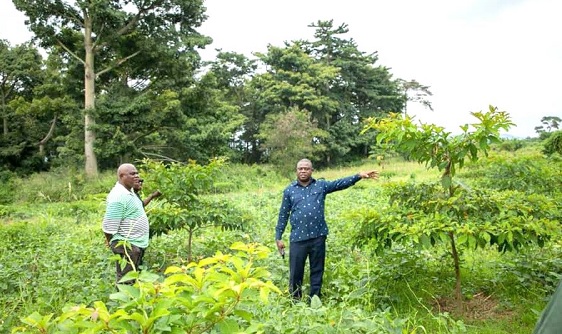
Forest degradation, climate crisis: Let’s act now
“The otherwise green vegetation has been wiped off. Hundreds of trees lie lifeless.
Advertisement
The dark rich nutritious soil of the forest has also been peeled off.
In its place are deep gullies and pits that lie between the heaps of excavated soil.
In those gullies were excavators, Chanfan machines and other equipment that are used as weapons of mass destruction of the environment.
“The chirping of birds that would heartily welcome one to the green environment was absent.
Rather, the sounds from high pitch Chanfan machines and excavators that pulled down trees could be heard all over.
“This was the sight that greeted us when we got to the Oda River Forest Reserve located in the Amansie Central District of the Ashanti Region on January 16, this month” — January, 2020. (Ref: https://www.graphic.com.gh/features/opinion/galamsey-let-s-kill-this-monster-before-it-kills-us.html).
It’s been more than three years since the Daily Graphic captured the pillaging of the 16,443-hectare forest reserve, but the situation is moving from bad to worst

A section of the Oda River Forest Reserve that has been reduced to gullies
Report
A State of the Nation’s Forest report presented by the Forestry Commission on May 2, this year, revealed that the Oda River Forest Reserve remains under siege by illegal miners.
According to the report, 421.11 hectares of the forest reserve had been wiped off by illegal miners.
Such is the case with the 3,500-hectare Apamprama forest, where 1,729.32 hectares (49.4 per cent) has been destroyed by illegal miners.
Also, 87.21 hectares of the 2,300-hectare Subin Shelterbelt reserve have been reduced to deep gullies through illegal mining.
The picture is gloomy as the reports indicated that a total of 392,714.81 hectares of the country’s 288 forest reserves had been significantly “impacted” by illegal mining activities, out of which 4,726.26 hectares in 34 of the reserves had been confirmed as destroyed.
Some of these forest reserves are Offin Shelterbelt and Asenanyo in the Nkawie Forest District in the Ashanti Region; Nueng South and Bonsa River forest reserves in the Tarkwa Forest District in the Western Region; Atewa Range Extension and Atewa Range in the Kade and Kyebi forest districts in the Eastern Region.
According to the Chief Executive Officer (CEO) of the Forestry Commission, John Allotey, the galamsey activities in the Oda River, Apamprama and Subin Shelterbelt forest reserves were “difficult to control due to large number of violent, armed illegal miners and a large number of excavators”.
Apart from the massive destruction of the forest landscape, the report indicated that there were grave security concerns in the affected areas as the galamsey operators used recruited armed security who wielded sophisticated assault rifles and other weapons.
“They carry out their operations under the cover of darkness and are trigger happy, making it difficult for the FSD field staff to deal with their activities,” he added.

John Allotey (right), CEO of the Forestry Commission, inspecting some trees that were planted as part of the Green Ghana Agenda. With him is Joseph Osiakwan, the Technical Director in charge of Forestry at the Ministry of Lands and Natural Resources
Forest, climate change
The destruction of these forest reserves must be a matter of grave concern for everyone because forests play a crucial role in reducing emissions and tackling the global climate crisis.
According to the World Wildlife Fund (WWF), forests serve as climate solutions as they are the largest storehouse of carbon only after oceans.
Apart from their ability to absorb and lock away carbon, forests also provide buffers for communities against climate impacts such as floods.
Again, it is estimated that about a third of the world’s population depend on the forest for their livelihoods.
“Forests are the lungs of the world, helping to keep our climate stable and providing 40 per cent of the planet’s oxygen.
They regulate our water system, increase rainfall and improve the quality of the water we need to survive,” the WWF adds.
It also estimated that over 1.6 billion peoples’ livelihoods depend on forests.
Drivers of deforestation
Despite the enormous importance of forests to humanity, the world’s forests are under growing threats, mainly driven by expanding agriculture activities, resulting from swelling population and shift in diet.
Even more, illegal and unsustainable logging resulting from the demand for wood is driving forest degradation.
The WWF adds that agriculture, forestry and land-use sectors account for 22 per cent of global greenhouse gas emissions, with deforestation being the major driver.
The fund further estimates that 10 million hectares of forests are destroyed globally.
In Ghana, the situation is not any different as illegal miners unleash havoc to the forest reserves while illegal logging (chainsaw lumbering and fuel wood harvesting), wildfires, agriculture expansion, cattle grazing and infrastructural development continue to deplete forests.
The government has implemented a number of interventions to protect the forest from degradation and restore degraded forests.
Under the Green Ghana initiative that was implemented two years ago, 31 million trees have been planted in 2021 (7 million) and 2022 (24 million), with 10 million more targeted to be planted in 2023.
Additionally, 690,436 hectares of trees have been planted under the Ghana Forest Plantation Strategy (2017-2022), comprising 104,795 hectares of forest plantations; 23,285 hectares of enrichment planting; and 562,356 hectares trees-on-farm.
Under the Ghana Forest Investment Programme (GFIP) 92.5 hectares of land have been targeted for reclamation in Denyau (69.7 hectares) and Supuma forest reserves (22.8 hectares) both in the Bekwai Forest District.
Additionally, site selection is ongoing for the reclamation of 1,500 hectares of mined out lands under the Ghana Landscape Restoration and Small-scale Mining Project (GLRSSMP).
Already, 240 woodlots have been established in 57 communities.
Also, 1,200 hectares of degraded landscape have been restored in eight forest reserves while 228 hectares of fire belts have been established in eleven reserves.
The five-year Ghana Cocoa Forest REDD+ Programme (GCFRP), a World Bank financed results-based emission reduction programme targeted at improving cocoa production through climate-smart practices was implemented in 2019.
The initiative was implemented in six cocoa forest hotspot intervention areas in the Western-North, Western, Ashanti, Eastern, Central, Ahafo and Bono regions.
Call to action
As the world continues to implement adaptation and mitigation measures to address the climate crisis, it is important for Ghana to take more sustainable measures to deal with the drivers of forest degradation.
When forests are degraded or deforested, large amounts of carbon dioxide are released into the atmosphere, and this worsens the climate crisis.
More attention must be given to the afforestation initiatives rolled out by the government and other partners to help restore degraded landscape.
The environmental laws must be strictly enforced to ensure a crackdown on illegal miners, illegal loggers and other “enemies of the forest.”
All stakeholders must get involved in taking steps to protect and preserve our forest.
After all, it is said that when the last tree dies, the last man dies.
Writer’s E-mail: [email protected]



